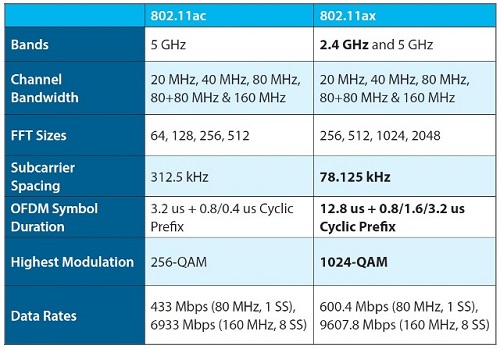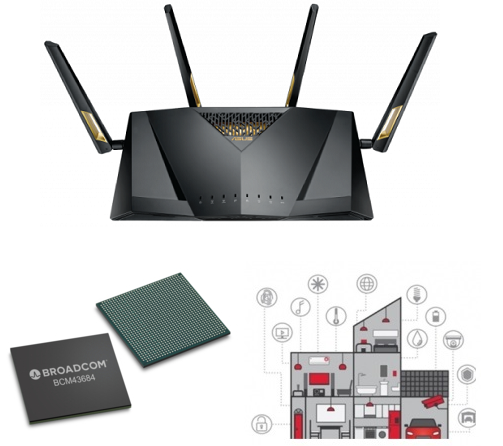BY PATRICK MANNION,
Contributing Editor
Sometimes, instead of moving to the next nice, shiny thing, it’s better to make the most of what’s there: Such is the case with wireless LANs. Instead of jumping to a new, higher spectrum and the many design, propagation, and test issues that it entails, IEEE 802.11ax makes better use of currently available bands and channels, and products are emerging quickly to help get it out, in at least pre-standard form, in 2018.
There is a strong argument for shiny things like 802.11ad in that it leverages wide spectrum availability in the 60-GHz band to get throughputs of 7 Gbits/s. However, its range is limited due to the fundamental physics of RF propagation, and in-home coverage is weak due to poor wall penetration. While 802.11ad amplifiers can be pushed to output at higher levels, that undermines the power-efficiency argument for 802.11ad devices.
When it goes mainstream, 802.11ad will be a good choice for short-range video transfers, but home and enterprise users really don’t have a throughput issue; they have an access issue. They need even longer range than that of IEEE 802.11ac, which operates in the 5-GHz-band only, as well as greater density and coverage and then higher data rates as a bonus. So, too, do operators. According to Peter White, CEO of Rethink Technology Research, “Every operator is trying to get rid of Wi-Fi dead spots in the home and eliminate the associated customer care and help-desk costs. Any technology that helps this is assured of a good reception in the market.”
To this end, IEEE 802.11ax, also called High-Efficiency Wireless (HEW), has been winding its way through the IEEE’s WLAN standards groups since 2013, when the High-Efficiency WLAN Study Group (HEW SG) was formed. As it progressed, it focused on how wireless stations (STAs) negotiate access, how to better deal with overlapping services due to many access points (APs) in the same area, and how to make better use of available channels and bands.
Some of the ways in which the IEEE 802.11ax Task Group addressed the issues were to move from carrier-sense, multiple access (CSMA) for access, Request to Send and Clear to Send (RTS/CTS) for sharing spectrum, and orthogonal frequency division multiple access (OFDMA). It also uses both the 2.45- and 5-GHz channels to make use of the longer propagation range at 2.45 GHz and provide greater band flexibility and backward compatibility with 802.11a/b/g/n installs (Fig. 1 ).
 Fig. 1: IEEE 802.11ax promises greater user density, coverage, range, and higher data rates. Image Source: National Instruments.
Fig. 1: IEEE 802.11ax promises greater user density, coverage, range, and higher data rates. Image Source: National Instruments.
The 802.11ax also allows simultaneous transmit and receive (STR) of multiple user devices in the uplink and downlink through the use of multi-user MIMO (MU-MIMO). This reduces latencies and standby power and increases throughput for a given spectrum.
This emphasis on spectral efficiency is carried further through the use of higher-order modulation, moving from a maximum of 256 QAM in 802.11ac to 1,024 QAM for 802.11ax. For a 160-MHz channel, this puts the maximum data rate at 9.6 Gbits/s versus 6.9 Gbits/s for 802.11ac.
However, it can’t be overstated enough that HEW is more about improving the average throughput per user versus raw throughput. Specifically, it is expected to be able to increase it by at least four times, which is especially useful in crowded outdoor environments and high-density offices.
The final version of 802.11ax is due to be ratified in 2019.
Pre-standard products emerging
As with all 802.11 standards, products start to emerge that have sufficient compatible intellectual property (IP) with what is expected to be the final standard that companies are willing to commit to silicon as well as front-end RF components. IEEE 802.11ax is no different. Already, both pre-standard silicon and even end products are appearing.
For example, early in 2017, Qualcomm announced its IPQ8074 802.11ax system-on-chip (SoC) for network infrastructure and the QCA6290 chip for client devices. The IPQ8074 uses 14-nm process technology and integrates the .11ax radio, MAC, and baseband, along with a 64-bit A53 CPU and dual-core network accelerator. It uses a 12×12 MIMO configuration and supports up to eight 80-MHz streams. As a networking device, it also integrates Qualcomm’s Self-Organizing Network (SON) to simplify installs, optimize traffic, and minimize dead spots. Overall capacity is 4.8 Gbits/s.
As a client device, the QCA6290 emphasizes power consumption, cost, and footprint. It supports 2×2 MU-MIMO, has a peak rate of 1.6 Gbits/s, and Qualcomm claims that its specific optimizations reduce power by 2/3 over 802.11ax’s standard power-save features.
More recently, Broadcom introduced Max WiFi, a family of ICs for 802.11ax. The BCM43684 is a residential AP chip that implements up to four 802.11ax streams for a throughput of 4.6 Gbits/s (Fig. 2 ). It uses a 160-MHz channel, uses 1,024 QAM, and implements both the uplink and downlink OFDMA feature, as well as MU-MIMO, ZeroWait dynamic frequency selection (DFS), and AirIQ interference identification. Fig. 2: Asus used Broadcom’s BCM43684 pre-standard chip for its full-coverage RT-AX88U 802.11ax router for high-speed, full-home coverage.
Fig. 2: Asus used Broadcom’s BCM43684 pre-standard chip for its full-coverage RT-AX88U 802.11ax router for high-speed, full-home coverage.
The BCM43694 is an enterprise AP version, but oddly, Broadcom doesn’t highlight any difference between it and the BCM43684.
The third member of the family is the BCM4375. This is a smartphone combo chip that supports two streams of 802.11ax (instead of four) for a throughput of 1.429 Gbits/s. It adds Bluetooth 5.0+, including low-energy long range (LELR) and real simultaneous dual-band (RSDB) operation.
Qualcomm is working with equipment makers like Netgear, Rivet Networks, Acer, and NEC Platforms, Ltd. Broadcom is working with both broadband operators such as Altice and OEMs like ASUSTek Computer, D-Link, Netgear, and ARRIS CPE to deploy its products. Asus has already implemented the BCM43684 in the RT-AX88U router that it introduced at the recent IFA 2017 event in Berlin. It uses 4×4 MIMO and Asus claims rates of 1.148 Gbits/s in the 2.45-GHz band and 4.804 Gbits/s in the 5-GHz band. However, no pricing or availability has been provided yet.
On the front end, Qorvo said it has a “broad 802.11ax portfolio that includes 2.4-GHz and 5-GHz front-end modules (FEMs) and BAW filters.” It lists the QPL210 low-noise amplifier (LNA) with a built-in BAW filter as part of that offering (Fig. 3 ).
 Fig. 3: Qorvo announced its QPL210 low-noise amplifier as part of its line of BAW filters for 802.11ax. Image Source: Qorvo.
Fig. 3: Qorvo announced its QPL210 low-noise amplifier as part of its line of BAW filters for 802.11ax. Image Source: Qorvo.
Slow uptake of 802.11ax?
Despite the earnestness of the 802.11ax Task Group and eagerness with which Qualcomm, Broadcom, and Qorvo are to have their name attached to the technology, they might be getting ahead of the market. “The uptake of 802.11ax will be much slower than any previous major Wi-Fi standard,” said Craig Mathias, principal at wireless research firm Farpoint Group.
Mathias sees 802.11ac Wave 2 as being sufficient from a data throughput and coverage point of view for some time to come. As for operators needing it, Mathias is quick to point out that, “Many operators are still stuck on 802.11n!” That said, he predicts a steady uptick over the next five to seven years.
Advertisement
Learn more about Electronic Products Magazine





